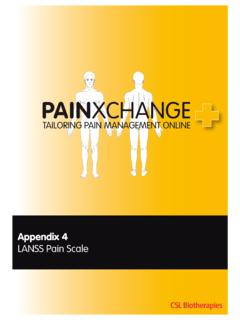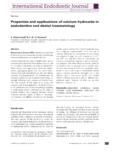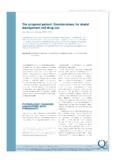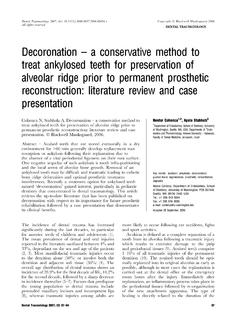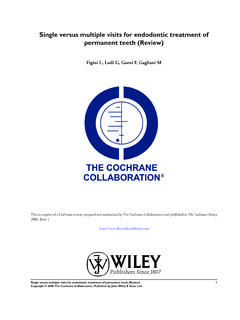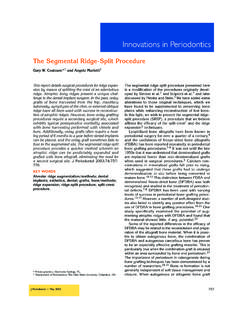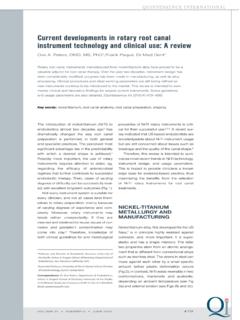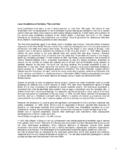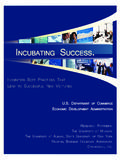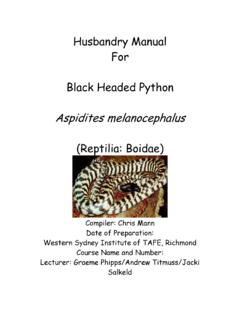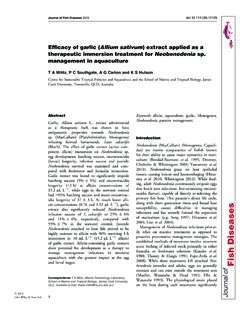Transcription of Evaluation of the effect of cleaning regimes on …
1 Journal of Applied Microbiology 2004, 96, 110 116 Evaluation of the effect of cleaning regimes on biofilms of thermophilic bacilli on stainless steel Parkar1, Flint2 and Brooks1. 1. Institute of Food, Nutrition and Human Health, Massey University, Palmerston North, New Zealand, and 2 Fonterra Research Centre, Palmerston North, New Zealand 2003/0371: received 5 May 2003, revised 15 June 2003 and accepted 26 August 2003. ABSTRACT. S . G . P A R K A R , S . H . F L I N T A N D J . D . B R O O K S . 2003. Aims: To determine the mechanism for both the removal and inactivation of 18-h biofilms of a thermophilic Bacillus species that optimally grows at 55 C on stainless steel. Methods and Results: The cleaning strategies tested were based on biofilm biochemistry and physiology, and focused on the chemistry of the cleaners, the duration and temperature of the cleaning process and a combination of various cleaners.
2 The success of the cleaning regimes was determined based on the removal of cells and organic debris and the elimination of viable cells. The results confirmed that a caustic (75 C for 30 min) and acid (75 C for 30 min) wash, relied upon heavily in most food processing industries for cleaning -in-place systems, was successful in removing these biofilms. However, any changes in the concentrations of these cleaners or the temperature of cleaning drastically affected the overall outcome. Alternative cleaning agents based on enzymatic or nonenzymatic breakdown of cellular proteins or polysaccharides, surfactant action, use of oxidative attack and free radicals varied in degrees of their success. Combining proteolytic action with surfactants increased wetability and therefore enhanced the cleaning efficiency. Conclusions: Several procedures, including caustic/acid and enzyme based cleaners, will be satisfactory, provided that the correct process parameters are observed concentration, time, temperature and kinetic energy (flow).
3 Confirmation of these results should be carried out in a pilot plant through several use/clean cycles. Significance and Impact of the Study: Confidence in standard and alternative cleaning procedures for food manufacturing plant to prevent contamination with thermophilic bacilli that threaten product quality. Keywords: biofilm, clean in place, cleaning , milk, stainless steel, thermobacilli. blocked tubes, reduced plant run times, corrosion of INTRODUCTION. stainless steel, and reduced heat transfer through plate heat Bacteria form biofilms on the surfaces of stainless steel exchangers. cleaning and disinfection have been incorpor- equipment in food processing industries, releasing bacteria ated into the cleaning -in-place (CIP) regimes in food that compromise the safety and quality of the final product. manufacturing industries (Romney 1990; Zottola and Other unfavourable conditions associated with biofilms that Sasahara 1994).
4 However, bacterial contamination and affect food manufacturers include reduced flow through product spoilage because of biofilm formation are recurring problems (Carpentier et al. 1998). cleaning and disinfection Present address: Parkar, HortResearch, Private Bag 3123, Hamilton, studies have focused on eliminating food-borne pathogens New Zealand (e-mail: ( Listeria) and have neglected other contaminating Correspondence to: Brooks, Institute of Food, Nutrition and Human Health, Massey University, Private Bag 11222, Palmerston North, New Zealand (e-mail: organisms ( thermophilic bacilli) that threaten food quality. 2003 The Society for Applied Microbiology cleaning regimes ON BIOFILMS 111. Bacterial biofilms may be defined as cells adhering to, and v Detergents, such as Tween-80 (a synthetic polysorbate). growing on, artificial substrates and are often associated with and dobanic acid, have surfactant effects; they enhance an extracellular polysaccharide matrix.))
5 The very nature of access of other cleaners to the biofilms by increasing their structure and formation provides greater resistance to their wetability. cleaning and disinfection, compared with planktonic cells On the basis of these treatments this paper aims to: (i). (Joseph et al. 2001). Many agents have traditionally been validate and establish the correct process parameters to used for CIP (Romney 1990) to allow cleaning to within achieve good cleaning practices in standard commercial acceptable levels. procedures within a laboratory scale system, (ii) estimate the It is difficult to find references in the literature about effect and efficiency of other agents that target cleaning in a effective cleaning systems for sporeforming bacteria in food defined biochemical mode of action within a laboratory scale manufacturing plant. Studies on biofilms in dairy manufac- system and (iii) examine the efficiency of some of the most turing plant have focused on Pseudomonas species and food effective cleaning procedures in a pilot industrial scale borne pathogens (Dunsmore 1980; Frank and Koffi 1990; system.)
6 Zottola and Sasahara 1994). There are a few publications dealing with sporeforming bacteria (Husmark and Ro nner 1992) and only limited information on thermophilic spore- MATERIALS AND METHODS. forming bacilli as biofilms in dairy manufacturing plants Sources of bacterial strains and cleaning (Parkar et al. 2001). chemicals We have chosen to use the vegetative form of a thermophilic bacillus for our study because spores have Bacillus flavothermus (B12-Cm), originally isolated from a not been observed within the biofilms of these organisms milk powder manufacturing plant, was grown in trypticase (Parkar et al. 2001). Any residual bacteria left after a soya broth (TSB) (BBL, Becton Dickinson, Cockeysville, cleaning cycle can potentially sporulate and therefore MD, USA) at 55 C for 18 h, from stocks stored on continue to proliferate and cause problems within the food Microbank cryobeads (Pro-Lab Diagnostics, Austin, TX, manufacturing system.
7 Here, we have compared for the first USA) at )20 C at the Biofilm Research Unit at the Institute time, various cleaning strategies to control the formation of of Food, Nutrition and Human Health, Massey University. biofilms of sporeforming thermophilic bacilli ( Bacillus Paradigm (proteolytic enzyme cleaner) was obtained from flavothermus). Ecolab, Hamilton, New Zealand. Eliminator (caustic based Cleaners were selected for this study on the basis of their cleaner), Perform (hydrogen peroxide/peracetic acid) and mechanisms of action as follows: Bactosolve (a quarternary ammonium compound) were i Alkaline cleaning , causing dissolution of cell material obtained from Orica Chemnet, Mt Maunganui, New and removal of calcium deposits standard caustic Zealand. soda and acid, and Eliminator. Purafect (a subtilisin), PurastarTM HPAmL (an a-amylase), ii Enzyme based cleaning : and CellulaseL (Genencor International, Rochester, NY, a Protease cleaners such as Paradigm which is an enzyme USA) were supplied by Enzyme Services, Auckland, New based cleaner combining proteolytic activity with Zealand.
8 Oxine was a gift from Biocide Pacific Ltd, surfactant action, and Purafect , a serine protease. Auckland, New Zealand. Mutanolysin was obtained from b Polysaccharidase based agents such as PurastarTM, an Sigma-Aldrich, Auckland, New Zealand. a-amylase, CellulaseL, a polysaccharidase and mut- Dobanic acid (a linear alkylbenzene sulphonic acid), was anolysin, a cell wall peptidoglycan hydrolase. obtained from Chemcolour Industries NZ Ltd, Auckland, iii Oxidizing chemicals such as sodium hypochlorite, New Zealand. Tween-80 and lecithin were obtained from Halamid (a chloramine), Oxine (chlorine dioxide) BDH, Palmerston North, New Zealand. All other chemicals and Perform (combination of peracetic acid and were of analytical grade and obtained locally, unless hydrogen peroxide). These are all general pro-oxidants otherwise mentioned. generating reactive oxygen and/or chlorine species. They initiate a cascade of oxidative attack on bacterial - Biofilm substrate SH group containing moieties such as enzymes, and peroxidative attack on membrane unsaturated fatty Cold rolled stainless steel, grade 316 with 2B surface finish acids (Estrela et al.)
9 2002). as supplied for dairy manufacturing plant construction, was iv A quaternary ammonium chloride, such as Bactosolve , cut into coupons (1 cm 1 cm 1 mm) (Parkar et al. that causes breakdown of cell membrane followed by 2001). The coupons were then inserted into the laboratory intracellular potassium efflux and finally cellular pro- biofilm reactor (Flint et al. 2001) and these were used to tein/nucleic acid damage (Romney 1990). grow biofilms for all laboratory studies. An alternative 2003 The Society for Applied Microbiology, Journal of Applied Microbiology, 96, 110 116, 112 S . G . P A R K A R ET AL. tubing and rinsed five times with sterile distilled water prior to examination for biofilms. For the second phase of work, an annular rotating disc reactor was used. In the annular reactor, eight stainless steel discs were fitted into a Teflon holder containing a bar magnet in the base.
10 This assembly was placed in a 400 ml beaker on a magnetic stirrer. The assembly was fitted with a rubber bung that could take in two silicone tubes. One tube allowed the milk to flow in and the other tube, which had a baffle dipping into the milk to cause turbulence, passed the milk to the waste sink from the reactor (Fig. 1). The setup was autoclaved and the stainless steel discs were inoculated with washed B. flavothermus (B12-Cm) cells as already described. Fig. 1 Diagram of the annular reactor used for biofilm growth on The milk flow rate was 4 7 1 ml min)1, determined from stainless steel coupons (Reservoir is a 500-ml glass beaker operating the doubling rate of the bacteria to avoid a net increase in the with a volume of 200 ml. The sample discs are represented by the small numbers of bacteria in the planktonic culture. circles in the large Teflon disc. This system was placed on a heated magnetic stirrer controlled at a temperature of 55 C).
